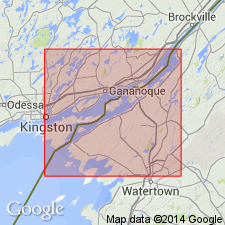
- Usage in publication:
-
- Amsterdam limestone
- Modifications:
-
- Areal extent
- [Age modified]
- AAPG geologic province:
-
- Appalachian basin
Summary:
Rudolf Ruedemann, table on p. 97. [Amsterdam limestone shown as top formation of Black River group in Mohawk and Champlain Valleys and Saratoga region, and as younger than Watertown limestone of Watertown region, but not occurring in same section with Watertown limestone. Underlies Trenton limestone and overlies pre-Leray part of Lowville limestone in Mohawk Valley and beds = Leray limestone member of Lowville in Champlain Valley.]
Source: US geologic names lexicon (USGS Bull. 896, p. 48).
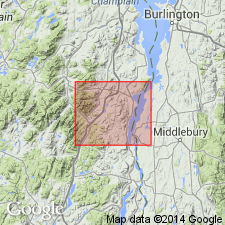
- Usage in publication:
-
- Amsterdam limestone
- Modifications:
-
- Areal extent
- Dominant lithology:
-
- Limestone
- AAPG geologic province:
-
- Appalachian basin
Summary:
(Rudolf Ruedemann, p. 72, footnote). Amsterdam limestone of Black River group. Black River group as now understood by this [New York] survey, comprises [ascending] Lowville limestone, Watertown limestone (formerly Black River limestone) and Amsterdam limestone.
Source: US geologic names lexicon (USGS Bull. 896, p. 48, Watertown entry p. 2284).
- Usage in publication:
-
- Amsterdam limestone
- Modifications:
-
- Principal reference
- Dominant lithology:
-
- Limestone
- AAPG geologic province:
-
- Appalachian basin
Cushing, H.P., 1911, Nomenclature of the lower Paleozoic rocks of New York: American Journal of Science, 4th series, v. 31, no. 182, p. 135-145.
Summary:
Pg. 135-144. Amsterdam limestone. Is Mohawk limestone of Conrad, but that name was later abandoned, and this limestone was called "base of the Trenton." Vanuxem classed it with Black River limestone, but it has of later years usually been referred to as Trenton, both along the Mohawk and at Saratoga; but it is older than anything in type section at Trenton Falls, and is properly referable to Black River, forming youngest division of that group in New York. It is also a deposit in a different trough from that of type Trenton. On eastern Mohawk and Saratoga it rests on Tribes Hill or Little Falls. In Champlain Valley true Trenton overlies it.
Named from exposures along the Mohawk River in vicinity of Amsterdam, [Amsterdam 7.5-min quadrangle], Montgomery Co., eastern NY.
Source: US geologic names lexicon (USGS Bull. 896, p. 48).

- Usage in publication:
-
- Amsterdam limestone*
- Modifications:
-
- Overview
- AAPG geologic province:
-
- Appalachian basin
Summary:
C.A. Hartnagel, 1912 (New York State Mus. Hdbk., no. 19), Rudolf Ruedemann, 1929 (GSA Bull., v. 40, p. 414), and Winifred Goldring, 1931 (New York State Mus. Hdbk., no. 10), assigned Amsterdam limestone to Black River group, which seems to be commonly accepted definition. Age is Middle Ordovician.
Recognized in east-central and eastern NY.
Source: US geologic names lexicon (USGS Bull. 896, p. 48).
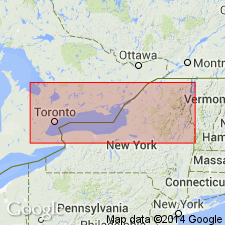
- Usage in publication:
-
- Amsterdam limestone
- Modifications:
-
- Principal reference
- Revised
- AAPG geologic province:
-
- Appalachian basin
Summary:
Pg. 259-260, pl. 2. Amsterdam limestone of Trenton group. Included in lower part of Trenton group and discussed under formations of Rockland age. At Manny Corners, underlies Larrabee member (new) of Glens Falls Formation and overlies Lowville formation. Dark-gray medium-textured limestone. Thickness about 11 feet. At Crown Point, 16 feet of Amsterdam beds overlie 27 feet of Chaumont and underlie 16 feet of Isle la Motte. Typical section given.
[Type locality]: in quarry 0.5 mi east of Manny Corners, 3 mi east-northeast of Amsterdam, [Amsterdam 7.5-min quadrangle], Montgomery Co., eastern NY.
Source: US geologic names lexicon (USGS Bull. 1200, p. 88-89).
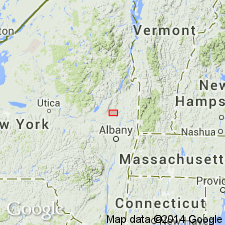
- Usage in publication:
-
- Amsterdam limestone
- Modifications:
-
- Areal extent
- AAPG geologic province:
-
- Appalachian basin
Summary:
Pg. 795-814. Amsterdam limestone. Evidence presented to substantiate radical change in interpretation of Paleozoic stratigraphy of Saratoga Springs region, New York. Previously accepted sequence of beds (Potsdam sandstone, Theresa formation, Hoyt limestone, Little Falls dolomite, Amsterdam sandstone, Trenton limestone, Canajoharie shale) is revised to read Potsdam sandstone, Galway formation (new), Hoyt limestone, Ritchie limestone (new), Mosherville sandstone (new), Gailor dolomite (new), Lowville limestone, Amsterdam limestone, Trenton limestone (Rockland?, Hull [Kirkfield], Sherman Fall representatives), and Canajoharie shale. Amsterdam is 3 feet thick in area instead of 50 feet as previously indicated. Where Lowville is absent, the Amsterdam overlies Gailor dolomite. Age is Middle Ordovician.
Source: US geologic names lexicon (USGS Bull. 1200, p. 88-89).
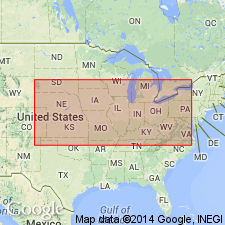
- Usage in publication:
-
- Amsterdam limestone
- Modifications:
-
- Areal extent
- AAPG geologic province:
-
- Appalachian basin
- New England province
Summary:
Chart 2 (column 15). Amsterdam limestone. Shown on correlation chart as underlying Isle la Motte limestone in western Vermont and Lake Champlain area. Age is Middle Ordovician (Mohawkian; Trentonian; Rockland).
Source: Publication; US geologic names lexicon (USGS Bull. 1200, p. 88-89).
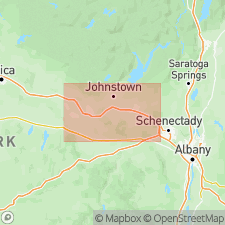
- Usage in publication:
-
- Amsterdam Limestone
- Modifications:
-
- Mapped
- Dominant lithology:
-
- Limestone
- AAPG geologic province:
-
- Appalachian basin
Summary:
Pg. 7-8, geol. maps (western and eastern sheets). Amsterdam Limestone. Dark-gray to black, light- to medium-gray weathering, fine- to medium-grained, massive to irregular to lumpy bedded, conglomeratic limestone. Contains bentonite bed. Thickness up to about 11 feet (3.5 m). Overlies Lowville Limestone. Underlies and interfingers with Glen Falls Limestone. Rocks formerly used for building stone and canal lock and viaduct construction. Fossils; notably trilobite RAYMONDITES SPINIGER, corals LAMBEOPHYLLUM and FAVISTELLA. Age is Middle Ordovician (Mohawkian Series; Turin Stage), between 450 and 445 Ma.
Notable exposures (p. 38): loc. no. 17 (type) and loc. no. 18 (in Pattersonville quadrangle). Unit tentatively identified west of U.S. Interstate 90 near Fultonville.
Source: Publication.
- Usage in publication:
-
- Amsterdam Limestone
- Modifications:
-
- Areal extent
- AAPG geologic province:
-
- Appalachian basin
Fisher, D.W., 1982, Synopsis of Ordovician correlations in New York State: International Union of Geological Sciences Publication, no. 12, p. 43-51, sheet 3.
Summary:
Pg. 51, sheet 3 (column 89). Amsterdam Limestone. Definitive correlation problematic. Recognized along southeastern flank of Adirondack Mountain, between Canajoharie and Glens Falls, Mohawk River valley, eastern New York. Disconformably overlies Lowville Limestone of Black River Group; disconformably underlies Glens Falls Limestone of Trenton Group. Basal part locally conglomeratic with clasts of Lowville or Cambrian Tribes Hill Limestone. Fossils. Carries both Black River and Trenton Group fauna. Physical evidence shows that the Amsterdam could be uppermost Black River (= Watertown Limestone), lowest Trenton (= Rockland), or both; faunal evidence gives same conclusion.
Source: Publication.
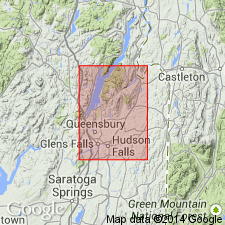
- Usage in publication:
-
- Amsterdam Limestone
- Modifications:
-
- Mapped
- Dominant lithology:
-
- Limestone
- AAPG geologic province:
-
- Appalachian basin
Summary:
Amsterdam Limestone of Cushing (1911). Irregularly bedded, fine- to coarse-grained, medium- to dark-gray, medium- to dark-gray weathering limestone. Maximum thickness about 7 feet. Fossils relatively common; brachiopods, gastropods, ostracodes, corals, bryozoans, nautiloid cephalopods, trilobites. Included in Black River Group.
Notable exposure in Jointa quarry (inactive), Glens Falls, btw. NY Route 32 and Hudson River; Lower Ordovician Fort Ann Formation in quarry floor with Middle Ordovician Amsterdam, Isle la Motte, and Glens Falls Limestones in quarry wall (p. 40, fig. 55; p. 50 and map, loc. 18).
Recognized in subsurface at depth of approx. 242 ft, below Glens Falls Limestone and above Gailor Dolomite, in Saratoga Vichy Spring Company core, west bank Geyser Brook, north of Geyser Road, Milton Twp., Lat. 43 deg. 03 min. 32 sec. N., Long. 73 deg. 43 min. 38 sec. W., Saratoga 7.5-min quadrangle, Saratoga Co., NY (p. 29).
Source: Publication.
For more information, please contact Nancy Stamm, Geologic Names Committee Secretary.
Asterisk (*) indicates published by U.S. Geological Survey authors.
"No current usage" (†) implies that a name has been abandoned or has fallen into disuse. Former usage and, if known, replacement name given in parentheses ( ).
Slash (/) indicates name conflicts with nomenclatural guidelines (CSN, 1933; ACSN, 1961, 1970; NACSN, 1983, 2005, 2021). May be explained within brackets ([ ]).

